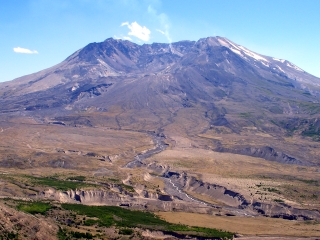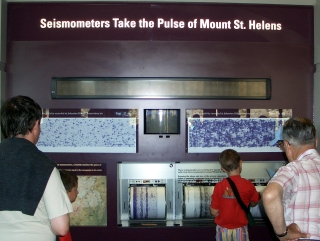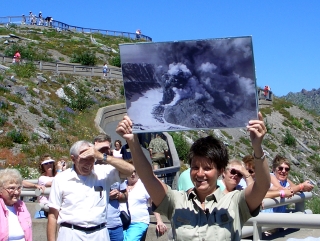NF Website; VolcanoCam
 WHAT IS IT?
WHAT IS IT?Site of, in May 1980, the continental United States’ most recent major volcanic eruption.
BEAUTY (5/10)
It is clear that a volcanic eruption happened here. The land is a dusty tan. Downed trees still stand where they collapsed in 1980. They now make wonderful homes to woodpeckers and assorted insects. Lakes created by the blast shimmer in bright blues. The earth undulates below in odd configuration created by the landslide and the mud floes.
Then there is the volcano. She stands with a pugnacious spirit, smaller and much less majestic than her Cascade mountain cousins. She is asymmetrical, without glaciers, angry, agitated and hard at work.
In 1980, she ejected thousands of tons of ash and smoke sideways through her northern face, then an unknown phenomenon. She now stands without a top, 2000 feet shorter than she was in 1979. She is exposed and not too happy about it. The exposed crater is ever-changing, billowing smoke and dispensing magma.
HISTORICAL INTEREST (8/10)
Mount St. Helens is alive. We arrived at the Site just hours after some 3.3 scale earthquakes that made the national news. Steady smoke puffed out of its open crater. The Ranger explained that one theory is that the volcano is rebuilding its cone right before our eyes. She is working at such a fast pace that she might grow back her top in less than 50 years.
The 1980 event was unique among all of history’s continental United States eruptions in that it was broadcasted live throughout our nation. The two-month saga of will she or won’t she blow occurred before our eyes. We immediately saw the pictures, listened to the first-hand accounts and understood the unbelievable destruction of nature’s forces.
Everybody living in the Pacific Northwest at the time has a Mount St. Helens story - you should hear my cousin’s. It involves hundreds of rattlesnakes, ash fall and steep cliff sides. Mount St. Helens is 20th Century United States’ understanding of volcanoes. She is the benchmark. Er...at least until the next one.
CROWDS (7/10)
Whenever Mount St. Helens makes the news, the crowds come. We beat the rush by a day but still toured with thousands of others. There is ample parking at the Visitors Centers but do not expect to be alone. Get in line a few minutes ahead of time for the introductory films; all showings were standing room only.
EASE OF USE/ACCESS (4/5)
Portland, Oregon residents know that the volatile Mount St. Helens is only 100 miles away by car and less than 70 miles away as the crow flies.
Route 504 is the only way into and out of the volcano. The road, which begins at Interstate 5, Exit 49, has been newly repaved and makes for a smooth driving experience.
All three Visitor Centers are located on Washington Route 504. The Mount St. Helens VC is just 5 miles east of I-5. The Coldwater Ridge VC sits at Route 504 mile marker 43. The incredible Johnston Ridge Visitor Center, which allows head-on, close-up look into the volcano views, is at mile marker 52. The road ends here.
CONCESSIONS/BOOKSTORE (3/5)
The bookstore carries a paltry selection of Mount St. Helens books, approximately 20. On the plus side, there are two different build-your-own volcano kits and plenty of Smokey the Bear dolls.
 COSTS (1/5)
COSTS (1/5)Mount St. Helens NVM is sneakily expensive. Entry is $3 per person if you visit only one VC. For $6 per person, you can visit all the VC’s. That is $24 for a family of four. Ouch.
The Park is not a part of the National Park System, so your Parks Pass is not honored here. For $15, you can get a Golden Eagle sticker for your Park’s Pass. This sticker allows for entry into all U.S. Forest Service Sites, Mount St. Helens included. Our Golden Eagle sticker has already paid for itself; it is also necessary just to park at most National Forest Sites in the Pacific Northwest.
RANGER/GUIDE TO TOURIST RATIO (5/5)
The crowds were so large that any Ranger to tourist ratio is bound to be uneven. Still, the Forest Service Rangers did an incredible job of making themselves known and establishing a presence. Rangers were posted at overlooks and on pathways ready to answer questions. The frequent Ranger talks in high traffic areas were enhanced by microphone systems. They did a wonderful job.
TOURS/CLASSES (10/10)
The Ranger talks and walks, which occur at least every hour, are especially helpful because the story of Mount St. Helens is not static. Earthquakes and eruptions happen every day and the volcano is changing at a rapid pace before our eyes. If the Museum relied only on displays and not on Rangers, the lessons taught would soon become dated by the volcano’s constant transformation.
Nonetheless, the National Forest Service operates three tremendous museums at Mount St. Helens NVM. All three contain completely different content and each merit a visit. The Mount St. Helens VC is located the furthest from the volcano. It portrays the story of the 1980 eruption from the perspective of the outside world, relying on newspaper recaps and magazine articles of the events preceding and following the natural disaster. The Museum is a perfect introduction or reintroduction, depending on your knowledge, to the events that shook the United States.
The Coldwater Ridge Museum focuses on the areas wildlife through interactive displays, frequent Ranger talks and multi-media exhibits. You learn what settled in the area post-eruption and how life has returned and thrived.
The final museum is at Johnston Ridge. It examines the geology of the eruption with an exciting film, an electric map, a seismograph and Ranger talks aided by a microphone and speakers. The Museum also tells the dramatic stories of the handful of people who were trapped in the area during the May 1980 events.
 FUN (9/10)
FUN (9/10)We had a wonderful time. A trip to Mount St. Helens makes for a long day of sightseeing. Three museums, startlingly close views, great hiking opportunities and the chance to see a live, smoking volcano. It does not get much better than that.
WOULD WE RECOMMEND? (9/10)
Absolutely, but watch the news. If they tell you that she is going to blow, then don’t come.
TOTAL 61/80
www.usa-c2c.com
© 2005